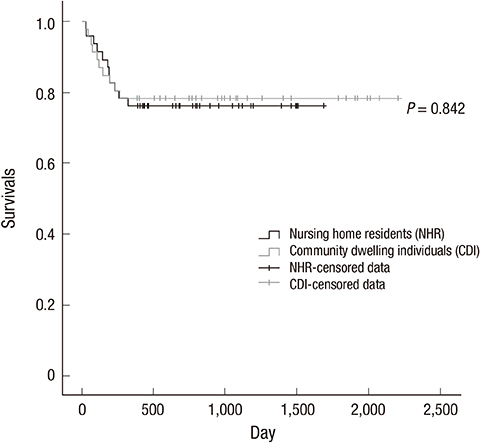J Korean Med Sci.
2016 Jan;31(1):89-97. 10.3346/jkms.2016.31.1.89.
Survival and Functional Outcomes after Hip Fracture among Nursing Home Residents
- Affiliations
-
- 1Department of Orthopedic Surgery, Gwangju Veterans Hospital, Gwangju, Korea. chm1228@hanmail.net
- 2Department of Nursing, Gwangju Veterans Nursing Home, Gwangju, Korea.
- 3Department of Nursing, Suwon Veterans Nursing Home, Suwon, Korea.
- 4Department of Nursing, Daegu Veterans Nursing Home, Daegu, Korea.
- 5Department of Nursing, Gimhae Veterans Nursing Home, Gimhae, Korea.
- 6Department of Nursing, Daejeon Veterans Nursing Home, Daejeon, Korea.
- KMID: 2359997
- DOI: http://doi.org/10.3346/jkms.2016.31.1.89
Abstract
- Following the implementation of a long-term care insurance system for the elderly in Korea, many nursing homes have been established and many more patients than ever before have been living at nursing homes. Despite the fact that this is a high-risk group vulnerable to hip fractures, no study has yet been conducted in Korea on hip fracture incidence rates and prognoses among patients residing at nursing homes. We recently studied 46 cases of hip fracture in nursing homes; more specifically, we investigated the most common conditions under which fractures occur, and examined the degree of recovery of ambulatory ability and the mortality within 1 yr. Among those who had survived after 1 yr, the number of non-functional ambulators increased from 8 hips before hip fracture to 19 hips at final post-fracture follow-up. These individuals showed poor recovery of ambulatory ability, and the number who died within one year was 11 (23.9%), a rate not significantly different from that among community-dwelling individuals. It was evident that hip-joint-fracture nursing home residents survived for similar periods of time as did those dwelling in the community, though under much more uncomfortable conditions. The main highlight of this report is that it is the first from Korea on nursing home residents' ambulatory recovery and one-year mortality after hip fracture. The authors believe that, beginning with the present study, the government should collect and evaluate the number of hips fractured at nursing facilities in order to formulate criteria that will help to enable all patients to select safer and better-quality nursing facilities for themselves or their family members.
Keyword
MeSH Terms
Figure
Cited by 1 articles
-
One-year Survival Rates and Functional Recovery in Veterans Who Suffer from Hip Fractures: Evaluation of Commissioned Hospitals' System through Comparison between Veterans Hospitals and Commissioned Hospitals
Hong Man Cho, Jae Woong Seo, Hyun Ju Lee
Hip Pelvis. 2018;30(2):101-108. doi: 10.5371/hp.2018.30.2.101.
Reference
-
1. National Health Insurance Service. Available at http://www.law.go.kr/lsInfoP.do?lsiSeq=142990&efYd=20140214#0000. accessed on 7 July 2015.2. Sugarman JR, Connell FA, Hansen A, Helgerson SD, Jessup MC, Lee H. Hip fracture incidence in nursing home residents and community-dwelling older people, Washington State, 1993-1995. J Am Geriatr Soc. 2002; 50:1638–1643.3. Brennan nee Saunders J, Johansen A, Butler J, Stone M, Richmond P, Jones S, Lyons RA. Place of residence and risk of fracture in older people: a population-based study of over 65-year-olds in Cardiff. Osteoporos Int. 2003; 14:515–519.4. Canale ST, Beaty JH. Campbell's operative orthopaedics. 12th ed. Philadelphia: Mosby Elsevier Inc;2013. p. 2737–2750.5. Garden RS. Stability and union in subcapital fractures of the femur. J Bone Joint Surg Br. 1964; 46:630–647.6. Nakamura K, Oyama M, Takahashi S, Yoshizawa Y, Kobayashi R, Oshiki R, Saito T, Tsuchiya Y. Fracture incidence in nursing homes in Japan. Osteoporos Int. 2010; 21:797–803.7. Cho JP, Paek KW, Song HJ, Jung YS, Moon HW. Prevalence and associated factors of falls in the elderly community. Korean J Prev Med. 2001; 34:47–54.8. Koval KJ, Skovron ML, Aharonoff GB, Meadows SE, Zuckerman JD. Ambulatory ability after hip fracture. A prospective study in geriatric patients. Clin Orthop Relat Res. 1995; (310):150–159.9. Kim SK, Hong JS, Park JH, Park JW, Kim JH. Mortality and functional recovery after bipolar hemiarthroplasty of femoral neck fractures in elderly patients. J Korean Hip Soc. 2002; 14:49–57.10. Shin DK, Kwun KW, Kim SK, Lee SW, Choi CH, Go SB. Ambulatory recovery after fixation of intertrochanteric fracture with gamma nail in the elderly. J Korean Soc Fract. 2000; 13:771–778.11. Bliemel C, Lechler P, Oberkircher L, Colcuc C, Balzer-Geldsetzer M, Dodel R, Ruchholtz S, Buecking B. Effect of preexisting cognitive impairment on in-patient treatment and discharge management among elderly patients with hip fractures. Dement Geriatr Cogn Disord. 2015; 40:33–43.12. Choi JC, Na HY, Lee YS, Lee WY, Choi JW, Kim WS, Won JW. Mortality after treatment of hip fracture over 80 years old. J Korean Hip Soc. 2006; 18:116–120.13. Kim DS, Shon HC, Kim YM, Choi ES, Park KJ, Im SH. Postoperative mortality and the associated factors for senile hip fracture patients. J Korean Orthop Assoc. 2008; 43:488–494.14. Berry SD, Samelson EJ, Bordes M, Broe K, Kiel DP. Survival of aged nursing home residents with hip fracture. J Gerontol A Biol Sci Med Sci. 2009; 64:771–777.15. Wehren LE, Hawkes WG, Orwig DL, Hebel JR, Zimmerman SI, Magaziner J. Gender differences in mortality after hip fracture: the role of infection. J Bone Miner Res. 2003; 18:2231–2237.16. Vu MQ, Weintraub N, Rubenstein LZ. Falls in the nursing home: are they preventable. J Am Med Dir Assoc. 2004; 5:401–406.17. Statistics Korea. Available at http://kosis.kr/statisticsList/statisticsList_01List.jsp?vwcd=MT_ZTITLE&parmTabId=M_01_01#SubCont. accessed on 7 July 2015.18. Ministry of Health and Welfare. Available at http://www.law.go.kr/admRulBylInfoPLinkR.do?admRulSeq=2100000017701&admRulNm=%EC%9E%A5%EA%B8%B0%EC%9A%94%EC%96%91%EA%B8%B0%EA%B4%80%20%ED%8F%89%EA%B0%80%EB%B0%A9%EB%B2%95%20%EB%93%B1%EC%97%90%20%EA%B4%80%ED%95%9C%20%EA%B3%A0%EC%8B%9C&bylNo=0001&bylBrNo=00&bylCls=BE&bylClsCd=BE&joEfYd=&bylEfYd=. accessed on 7 July 2015.19. Moran CG, Wenn RT, Sikand M, Taylor AM. Early mortality after hip fracture: is delay before surgery important? J Bone Joint Surg Am. 2005; 87:483–489.
- Full Text Links
- Actions
-
Cited
- CITED
-
- Close
- Share
- Similar articles
-
- Nurses' Management of Nursing Home Residents' Remaining Functional Ability: Concept Development
- Lived Experiences of Nursing Home Residents in Korea
- Effect of Toileting Behavior on Daytime Non-sedentary Behavior in Nursing Home Residents
- Differences in Pain Characteristics and Functional Associations between Nursing Home Residents and Community-Dwelling Older Adults: A Cross-Sectional Study
- Analysis of Functional Independence Status and Home Care Needs among Stroke Patients


